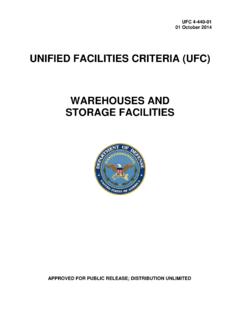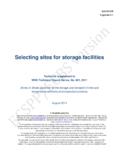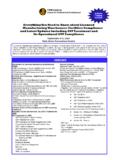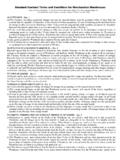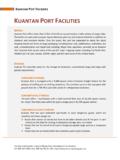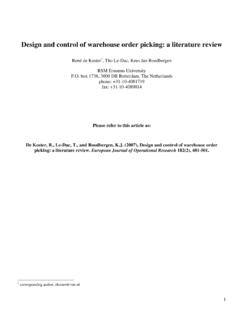Transcription of Maintenance of storage facilities - WHO
1 ` Supplement 5 WHO Vaccine Maintenance of storage facilities Technical supplement to WHO Technical Report Series, No. 961, 2011 Annex 9: Model guidance for the storage and transport of time and temperature sensitive pharmaceutical products August 2014 World Health 2014 WHO Press, World Health Organization, 20 Avenue Appia, 1211 Geneva 27, Switzerland (tel.: +41 22 791 3264; fax: +41 22 791 4857; e-mail: Requests for permission to reproduce or translate WHO publications whether for sale or for noncommercial distribution should be addressed to WHO Press, at the above address (fax: +41 22 791 4806; e-mail: The designations employed and the presentation of the material in this publication do not imply the expression of any opinion whatsoever on the part of the World Health Organization concerning the legal status of any country, territory, city or area or of its authorities, or concerning the delimitation of its frontiers or boundaries.))
2 Dotted lines on maps represent approximate border lines for which there may not yet be full agreement. The mention of specific companies or of certain manufacturers products does not imply that they are endorsed or recommended by the World Health Organization in preference to others of a similar nature that are not mentioned. Errors and omissions excepted, the names of proprietary products are distinguished by initial capital letters. All reasonable precautions have been taken by the World Health Organization to verify the information contained in this publication. However, the published material is being distributed without warranty of any kind, either expressed or implied. The responsibility for the interpretation and use of the material lies with the reader.
3 In no event shall the World ` Health Organization be liable for damages arising from its use. The named authors alone are responsible for the views expressed in this publication. Technical Supplement: Maintenance of storage facilities 1 Acknowledgments The author of this document is Andrew Garnett, an independent consultant, London, UK. Technical Supplement: Maintenance of storage facilities 2 Contents Acknowledgments .. 1 Contents .. 2 Abbreviations .. 3 Glossary .. 4 1. Introduction .. 6 Requirements .. 6 6 Target readership .. 6 2. Guidance .. 7 Associated materials and equipment .. 7 What is Maintenance and why is it important? .. 7 The building design and construction phase.
4 9 The operation and Maintenance manual .. 10 The health and safety file .. 11 Maintenance management .. 12 Establish an institutional or contractual framework .. 12 Preventive Maintenance and replacement: standards and schedules .. 13 Establish a multi-year Maintenance plan .. 15 Planned periodic inspections .. 16 Planned service inspections .. 17 Curative Maintenance .. 17 Organizing and managing the work .. 17 Inspecting and signing off the work .. 19 References .. 20 Annex 1 Uniclass: building elements .. 21 Annex 2 Checklist for building weatherproofing .. 23 Revision history .. 25 Technical Supplement: Maintenance of storage facilities 3 Abbreviations CM Corrective Maintenance EHS Environmental, Health and Safety IPM Inspection and Preventive Maintenance MoU Memorandum of Understanding PM Preventive Maintenance SLA Service Level Agreement SOP Standard Operating Procedure TTSPP Time and Temperature-Sensitive Pharmaceutical Product Technical Supplement: Maintenance of storage facilities 4 Glossary Design build: A project delivery system used in the construction industry.
5 The design and construction services are contracted by a single entity known as the design builder or design build contractor, typically for an agreed lump-sum price. Facility management: The professional management of building infrastructure. Responsibilities of the facility manager include day-to-day operation, space allocation and management of changes to the building, management of health and safety, fire safety, security, Maintenance , testing and inspection, cleaning, contingency/disaster planning and tendering for out-sourced contracts relating to any of these activities. Maintenance management: The administrative, financial, and technical framework for assessing and planning building Maintenance operations on a scheduled basis; a sub-set of facility management.
6 Pharmaceutical product: Any product intended for human use or veterinary product intended for administration to food producing animals, presented in its finished dosage form, that is subject to control by pharmaceutical legislation in either the exporting or the importing state and includes products for which a prescription is required, products which may be sold to patients without a prescription, biologicals and vaccines. Medical devices are not included1. Practical completion: In most construction contracts, the date at which the architect or contract administrator certifies that the works have been completed, and the end user is able to occupy the building. Some minor works, called snagging items, may remain and must be completed by the contractor within a reasonable time period.
7 Refrigeration equipment: The term refrigeration or refrigeration equipment means any equipment whose purpose is to lower air and product temperatures and/or to control relative humidity. Service Level Agreement (SLA): A service level agreement or contract is a negotiated agreement between the customer and service provider that defines the common understanding about materials or service quality specifications, responsibilities, guarantees and communication mechanisms. It can either be legally binding, or an information agreement. The SLA may also specify the target and minimum level performance, operation or other service attributes2. Standard Operating Procedure (SOP): A set of instructions having the force of a directive, covering those features of operations that lend themselves to a definite or standardized procedure without loss of effectiveness.
8 Standard operating policies and procedures can be effective catalysts to drive performance improvement and improve organizational results. Time and temperature sensitive pharmaceutical product (TTSPP): Any pharmaceutical good or product which, when not stored or transported within pre-defined environmental conditions and/or within pre-defined time limits, is degraded to the extent that it no longer performs as originally intended. 1 Definition from WHO/ Rev 1 Sept 2009. Proposal for revision of WHO good distribution practices for pharmaceutical products Draft for comments. 2 Definition from IATA. 2013/2014 Perishable Cargo Regulations (ePCR) & Temperature Control Regulations (eTCR) Technical Supplement: Maintenance of storage facilities 5 Uniclass: Unified Classification for the Construction Industry, published in 1997 in UK, is a classification scheme for the construction industry.
9 It is intended for organising library materials and for structuring product literature and construction project information. Technical Supplement: Maintenance of storage facilities 6 1. Introduction This technical supplement has been written to amplify the recommendations given in Section of WHO Technical Report Series No. 961, 2011, Annex 9: Model guidance for the storage and transport of time- and temperature-sensitive pharmaceutical products3. It does not specifically deal with emergency Maintenance or contingency planning. Related topics are covered in the Technical Supplement: Maintenance of refrigeration equipment. Requirements Implement a planned preventive Maintenance programme to ensure that storage buildings and building utilities are well maintained.
10 Keep records to demonstrate compliance with the programme. Objectives The objective of the Technical Supplement is to provide guidance on how to meet the above requirements. The document covers the Maintenance of building sites, building structures and building services. It does not cover the Maintenance of refrigeration equipment and cold store enclosures contained within those structures. This topic is covered by the companion Technical Supplement: Refrigeration equipment Maintenance . Target readership This supplement provides guidance aimed at more senior operations staff. Principally these will be the owners and operators of warehouses, pharmacies and other buildings used to store TTSPP s. Where appropriate the activities described in this supplement should be assigned to a qualfied Maintenance manager or facility manager.










